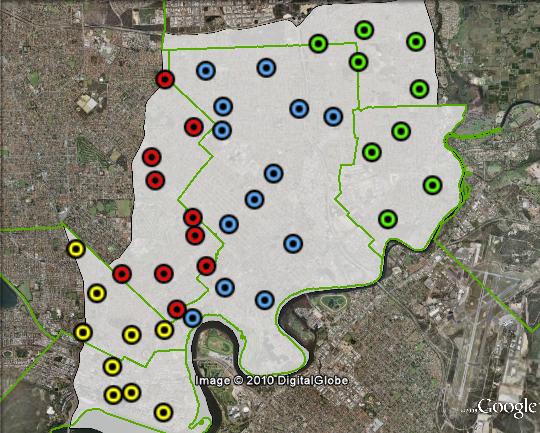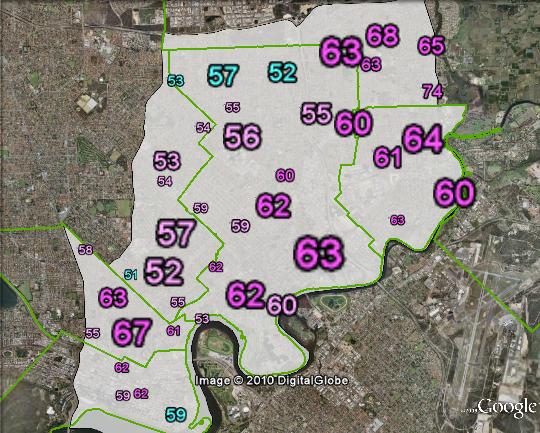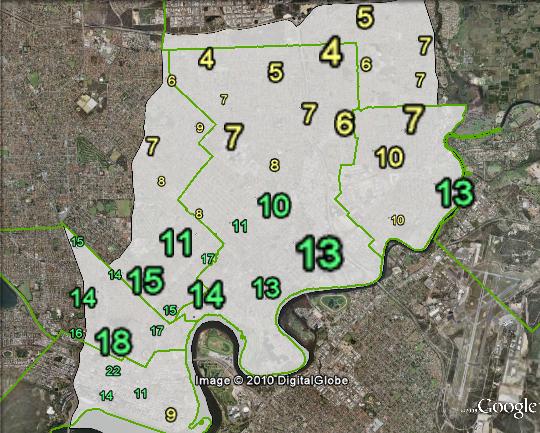ALP 7.9%
Incumbent MP
Stephen Smith, since 1993.
Geography
Central and northeastern Perth. The seat covers the Perth CBD, which is in the southwestern corner of the seat. Perth runs along the northern shore of the Swan river, to the east of the Perth CBD. Other suburbs include Maylands, Mount Lawley, Bayswater, Ashfield, Bedford, Morley and Beechboro.
Redistribution
Perth experienced some changes along its northern border. The seat lost parts of Coolbinia and Menora in the northwest of the seat, gained Noranda in the north, and lost parts of Beechboro in the northeastern corner of the seat.
History
Perth is an original federation seat. It was dominated by conservative parties until the 1940s, and became a marginal seat until the early 1980s. It has been held by the ALP ever since 1983, and is now relatively safe for the ALP.
Perth was first won in 1901 by the ALP’s James Fowler. Fowler was a fierce opponent of Billy Hughes within the party, and he switched to the new Liberal Party in 1909. He joined the new Nationalist Party in 1916, but his conflict with Hughes made this difficult. He lost Nationalist endorsement before the 1922 election, and lost Perth.
Nationalist candidate Edward Mann won Perth in 1922. He was re-elected in 1925 and 1928, but in 1929 was one of a number of Nationalist MPs led by Billy Hughes to rebel against the Bruce government and lead to the government’s downfall. Mann lost Perth as an independent in 1929.
Perth was won in 1929 by Nationalist candidate Walter Nairn. Nairn became a United Australia Party member in 1931, and held the seat for the next decade. He served as Speaker from 1940 to 1943, and retired at the 1943 election.
The ALP’s Tom Burke won Perth in 1943. He held the seat for the next twelve years, until 1955, when he lost Perth to the Liberal Party’s Fred Chaney. Burke was expelled from the ALP in 1957, although he later rejoined the party. His sons Terry Burke and Brian Burke were both later elected to the Western Australian state parliament, and Brian went on to become Premier.
Chaney held Perth for the next fourteen years. He served in Robert Menzies’ ministry from 1964 to 1966, but was dropped from the frontbench when Harold Holt became Prime Minister in 1966. He lost Perth in 1969. He went on to serve as Administrator of the Northern Territory and Lord Mayor of Perth.
Perth was won in 1969 by the ALP’s Joe Berinson. He was re-elected in 1972 and 1974, and in July 1975 was appointed Minister for the Environment in the Whitlam government. He lost his seat at the 1975 election. He went on to serve in the Western Australian state parliament and as a minister in a number of state Labor governments.
The Liberal Party’s Ross McLean won Perth in 1975, and held the seat as a backbencher for the entirety of the Fraser government, losing the seat in 1983.
Perth was won in 1983 by the ALP’s Ric Charlesworth. Charlesworth had been caption of the Australian men’s field hockey team, and represented Australia at five Olympics in the 1970s and 1980s. He captained the team at two Olympics while he held the seat of Perth. Charlesworth also played Sheffield Shield cricket for Western Australia in the 1970s.
Charlesworth held Perth for ten years, retiring in 1993 at the age of 41. He was replaced by Stephen Smith, former Keating advisor and State Secretary of the ALP in WA.
Smith was promoted to the Labor frontbench after the 1996 election, and served as a shadow minister in a variety of portfolios until 2007. Smith has served as Foreign Minister since the 2007 election, and recently gained the additional portfolio of Trade after the election of Julia Gillard as Labor leader and Prime Minister.
Candidates
- Jonathan Hallett (Greens)
- Paul Connelly (Christian Democratic Party)
- Stephen Smith (Labor) – Member for Perth since 1993 and Minister for Foreign Affairs and Trade.
- Nigel Irvine (Family First)
- Alex Bainbridge (Socialist Alliance)
- Joe Ferrante (Liberal)
Political situation
Perth is a relatively safe seat, and would require a large Liberal swing to be vulnerable.
2007 result
| Candidate | Party | Votes | % | Swing |
| Stephen Smith | ALP | 36,684 | 46.87 | +1.28 |
| Daniel Nikolic | LIB | 28,163 | 35.98 | -0.90 |
| Damian Douglas-Meyer | GRN | 8,320 | 10.63 | +1.05 |
| Paul Connelly | CDP | 1,594 | 2.04 | -0.42 |
| Stephen Brooks | IND | 1,413 | 1.81 | +1.81 |
| Sharon Fairfull | FF | 838 | 1.07 | +1.07 |
| Marie Edmonds | ON | 628 | 0.80 | -1.19 |
| Chris Latham | SA | 464 | 0.59 | -0.75 |
| Orm Girvan | CEC | 162 | 0.21 | -0.13 |
2007 two-candidate-preferred result
| Candidate | Party | Votes | % | Swing |
| Stephen Smith | ALP | 46,061 | 58.85 | +2.12 |
| Daniel Nikolic | LIB | 32,205 | 41.15 | -2.12 |
Results do not take into consideration effects of the redistribution.
Booth breakdown
There are six local government areas covering parts of the seat of Perth. Bayswater and Stirling council areas in the centre of the seat have been left alone, with Perth and Vincent councils grouped as ‘South-West’ and Bassandean and Swan grouped as ‘East’.
The ALP won majorities in all areas, with the smallest in Stirling and the largest in the east of the seat. The Greens polled over 15% in the south-west, much higher than in the remainder of the seat.

| Voter group | GRN % | ALP 2CP % | Total votes | % of ordinary votes |
| Bayswater | 8.96 | 57.10 | 25,112 | 37.76 |
| East | 7.68 | 64.13 | 18,086 | 27.20 |
| Stirling | 10.96 | 54.19 | 13,959 | 20.99 |
| South-West | 15.01 | 59.37 | 9,340 | 14.05 |
| Other votes | 12.41 | 57.22 | 14,524 |




That 59% Liberal booth in East Perth sure wouldn’t have been Liberal two decades ago!
Also interesting is the 13% vote for the Greens in eastern Bassendean – river loving hippies perhaps?
The Greens got a lot more than 13% round there at the last state election… the state seats of Bassendean, Maylands and Perth (the bulk of federal Perth) had 16.0%, 19.1% and 19.3% Green votes respectively, the last two being the next best two seats behind Fremantle. (I’ve got a heap of WAEC data in spreadsheets that I wish I had the skillz to turn into maps like this.) One of the best Greens booths in this part of the world was Bassendean Primary with 22.6%… of the booths with more than a few hundred people voting, only Inglewood topped it with 24.2%. (If memory serves, I calculated those figures without taking the informal vote out, so it’s probably a point or two higher again.)
BTW: Hello from very near the 22% booth, which I guess is Highgate Primary. I’m just about to walk past there to get a pie from the servo. 😛
Perhaps the higher Green vote at the State level can be attributed to the strong level of disillusionment regarding the the both the ALP and Liberals at the time.
My prediction: 2% swing to Libs.